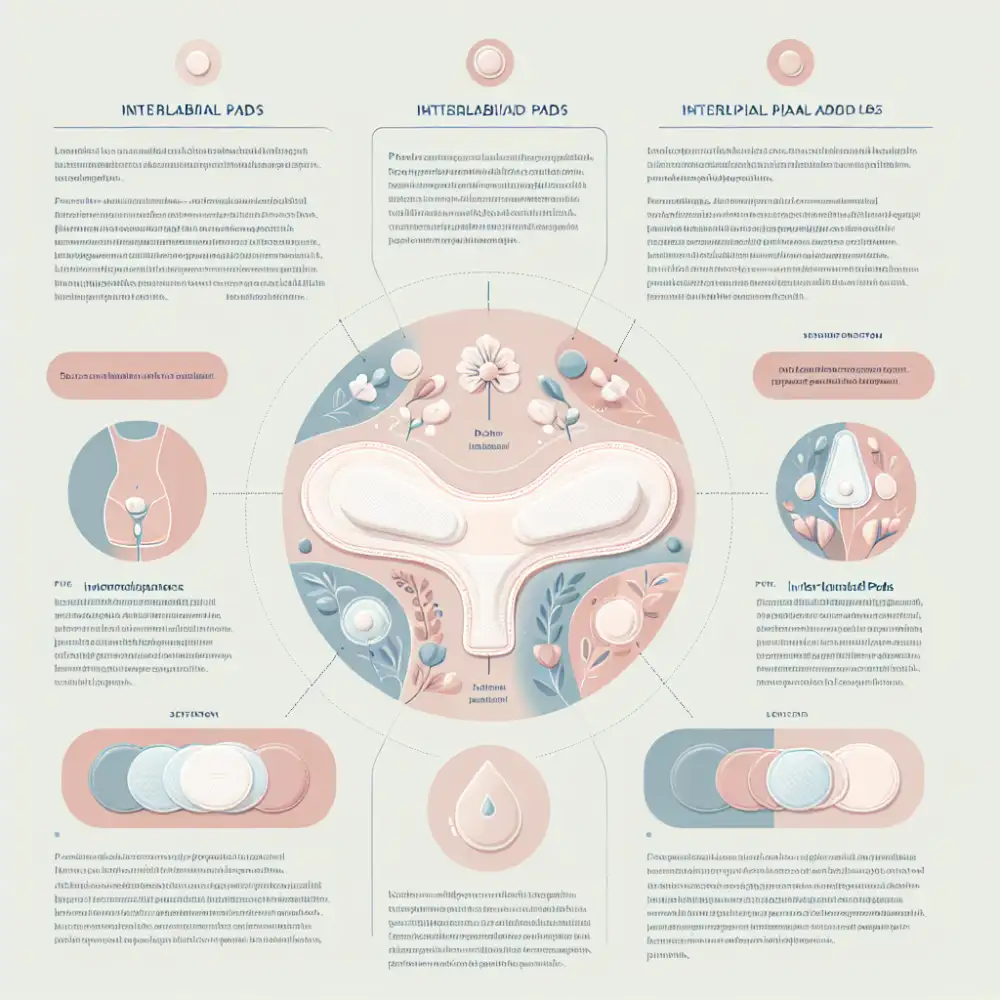Interlabial Pads: What You Need to Know

Interlabial pads: what are they?
Interlabial pads are small, thin pads specifically designed to be worn in the labial folds, the area between the labia. Unlike traditional menstrual pads, which are wider and stick to underwear, interlabial pads are more discreet and contoured to fit the body's curves. They are typically made from soft, breathable materials like cotton or bamboo fiber, ensuring comfort and minimizing irritation.
The primary function of interlabial pads is to absorb moisture and discharge, promoting a clean and dry feeling throughout the day. They can be particularly helpful for women who experience light bladder leaks, vaginal discharge, or perspiration in the intimate area. Additionally, interlabial pads can provide a sense of security and freshness during menstruation, especially when used in conjunction with tampons or menstrual cups.
Many women find interlabial pads beneficial for various reasons. Their discreet nature makes them ideal for everyday use, especially during physical activities like exercise or swimming. The absorbent properties help manage moisture and odor, contributing to overall hygiene and comfort. Moreover, the use of breathable materials minimizes the risk of irritation and allergic reactions, making them suitable for sensitive skin.
If you are considering using interlabial pads, it is essential to choose products from reputable brands that prioritize quality and safety. Look for pads that are hypoallergenic, fragrance-free, and specifically designed for intimate use. It is also crucial to follow the manufacturer's instructions regarding usage and disposal.
While interlabial pads can be a valuable addition to a woman's hygiene routine, it is essential to remember that they are not a substitute for proper medical care. If you experience any unusual or persistent symptoms, such as itching, burning, or changes in discharge, it is crucial to consult a healthcare professional for diagnosis and treatment.
Interlabial pad uses
Interlabial pads are small, thin, and absorbent pads designed to be worn externally in the labial folds, the area between the labia. They are not designed for internal use like tampons or menstrual cups.
Many women use interlabial pads for light bladder leakage or spotting. The pads are discreet and comfortable, making them a good option for managing these issues. They can also be used during exercise or other activities where leakage may be a concern.
Some women use interlabial pads as a backup method of protection during their period, especially when using a tampon or menstrual cup. They can provide extra security and peace of mind, particularly for women who experience heavy flow or are new to using internal period products.
Interlabial pads can also be helpful for women who experience discomfort or irritation from traditional pads. The thin, breathable design of interlabial pads can help to reduce moisture and friction, which can irritate sensitive skin.

While interlabial pads can be a helpful solution for many women, it is important to note that they are not a substitute for proper medical care. If you are experiencing heavy bleeding, severe pain, or other concerning symptoms, it is important to consult with a healthcare professional.
Interlabial pads and periods
Interlabial pads are small, thin pads that are worn externally between the labia, the folds of skin surrounding the vaginal opening. Unlike traditional pads that adhere to underwear, interlabial pads are designed to gently rest against the body, absorbing discharge and light menstrual flow. They are often made from soft, breathable materials like cotton or bamboo, prioritizing comfort and breathability.
Many people use interlabial pads as a more comfortable and sustainable alternative to traditional pads, especially for light flow days or spotting. Their small size and discreet design make them ideal for everyday use, offering a barely-there feel. Some individuals with sensitive skin may find interlabial pads less irritating than adhesive-based pads.
While interlabial pads can be a great option for light flow, they may not offer sufficient absorbency for heavier days of your period. For heavier flow, traditional pads, menstrual cups, or period underwear might be more suitable.
If you're considering using interlabial pads during your period, it's a good idea to experiment with different brands and styles to find what works best for you. Factors to consider include the pad's size, shape, material, and absorbency level.
Remember, managing your period is a personal experience. Choosing the right menstrual product depends on your individual needs and preferences. If you have any concerns or questions about using interlabial pads or other menstrual products, don't hesitate to reach out to your healthcare provider.
Interlabial pads are small, thin pads that are worn externally between the labia, the folds of skin surrounding the vaginal opening. Unlike traditional pads that adhere to underwear, interlabial pads are designed to gently rest against the body, absorbing discharge and light menstrual flow. They are often made from soft, breathable materials like cotton or bamboo, prioritizing comfort and breathability.
Many people use interlabial pads as a more comfortable and sustainable alternative to traditional pads, especially for light flow days or spotting. Their small size and discreet design make them ideal for everyday use, offering a barely-there feel. Some individuals with sensitive skin may find interlabial pads less irritating than adhesive-based pads.
While interlabial pads can be a great option for light flow, they may not offer sufficient absorbency for heavier days of your period. For heavier flow, traditional pads, menstrual cups, or period underwear might be more suitable.


If you're considering using interlabial pads during your period, it's a good idea to experiment with different brands and styles to find what works best for you. Factors to consider include the pad's size, shape, material, and absorbency level.
Remember, managing your period is a personal experience. Choosing the right menstrual product depends on your individual needs and preferences. If you have any concerns or questions about using interlabial pads or other menstrual products, don't hesitate to reach out to your healthcare provider.
Benefits of interlabial pads
Interlabial pads, also known as vulvar pads or perineal pads, are small, absorbent pads designed to be worn externally between the labia. Unlike traditional pads or panty liners that adhere to underwear, interlabial pads are held in place by the natural contours of the body. They offer a discreet and comfortable solution for managing various types of moisture and discharge.
One of the primary benefits of interlabial pads is their ability to provide targeted absorption. They are particularly useful for women who experience light bladder leaks or stress incontinence, as they can effectively absorb small amounts of urine. By wicking away moisture, interlabial pads help keep the vulvar area dry and comfortable, reducing the risk of irritation and odor.
Beyond urinary incontinence, interlabial pads can be beneficial for managing other types of vaginal discharge. This can include normal physiological discharge, which can fluctuate throughout the menstrual cycle, as well as discharge related to hormonal changes, such as during pregnancy or menopause. By absorbing excess moisture, interlabial pads can help prevent discomfort, chafing, and the growth of bacteria or yeast.
Women who engage in physical activities or sports may also find interlabial pads beneficial. They can help absorb sweat and moisture that can accumulate in the vulvar area during exercise, preventing chafing and irritation. This can be particularly helpful for activities like running, cycling, or swimming, where repetitive motion or tight-fitting clothing can exacerbate moisture buildup.
It's important to note that interlabial pads are not a replacement for traditional menstrual products like tampons or pads. They are designed for managing light moisture and discharge and may not provide sufficient absorbency for heavier menstrual flow.

Overall, interlabial pads offer a discreet, comfortable, and effective solution for managing various types of feminine hygiene needs. They can help women feel drier, fresher, and more confident throughout the day. If you are experiencing any unusual discharge or discomfort, it's always best to consult with a healthcare professional to rule out any underlying medical conditions.
Risks of interlabial pads
Interlabial pads are small, absorbent pads designed to be worn in the labial folds, the area between the labia. They are often marketed as a solution for light bladder leaks, sweat, or discharge. While generally considered safe for short-term use, there are some potential risks associated with using interlabial pads, especially with prolonged or incorrect use.
One concern is irritation. The area where interlabial pads are worn is delicate and sensitive. The constant friction from the pad, especially if it's not breathable, can irritate the skin, leading to redness, itching, or even small cuts. This risk is heightened if the pad is scented or contains harsh chemicals.
Another risk is allergic reactions. Some people may be allergic to the materials used in interlabial pads, such as adhesives, fragrances, or the absorbent material itself. Allergic reactions can manifest as itching, burning, redness, or a rash.
Interlabial pads are designed to absorb moisture, but this can backfire. Prolonged use, especially in hot or humid conditions, can trap moisture against the skin, creating a breeding ground for bacteria and yeast. This can disrupt the natural pH balance of the vagina, potentially leading to infections like bacterial vaginosis or yeast infections.
While interlabial pads are marketed for light bladder leaks, relying on them solely for this issue might mask an underlying medical condition. If you experience frequent bladder leaks, it's crucial to consult a healthcare professional to rule out any underlying medical conditions.
It's important to note that interlabial pads are not a replacement for menstrual products. They are not designed to handle the flow of a period and using them for this purpose can be messy and unhygienic.
If you choose to use interlabial pads, it's essential to choose unscented, breathable pads made from hypoallergenic materials. Change them frequently, especially after exercising or sweating, and avoid using them for extended periods. If you experience any irritation, discomfort, or unusual discharge, discontinue use and consult a healthcare professional.
How to use interlabial pads
Interlabial pads are small, thin, and absorbent pads designed to be worn in the labial folds, the area between the labia. They are commonly used to manage light bladder leaks or discharge, providing a discreet and comfortable solution for everyday freshness. Unlike traditional pads, interlabial pads are much smaller and contoured to fit the vulva comfortably. This makes them practically invisible under clothing and ideal for activities like exercising or wearing tight-fitting outfits.

Before using an interlabial pad, ensure your hands are clean. Unwrap the pad and remove the protective backing. Gently place the pad in your underwear, positioning it so that the wider end is towards your bottom and the narrower end is towards the front. The adhesive strip on the back of the pad will help keep it securely in place. Change your interlabial pad as often as needed, typically every 4-6 hours or when it becomes saturated. Frequent changes help maintain hygiene and prevent odor.
While interlabial pads are generally safe for most women, some may experience irritation or allergic reactions to certain materials. If you experience any discomfort, discontinue use and consult your doctor. Interlabial pads are not a substitute for proper menstrual hygiene products. During your period, use appropriate menstrual pads or tampons. Similarly, while interlabial pads can help manage light bladder leaks, they may not be suitable for heavier incontinence. Consult your doctor about appropriate management options if you experience moderate to severe leakage.
Where to buy interlabial pads
Interlabial pads, sometimes called vulvar pads or perineal pads, aren't as widely known as their menstrual pad cousins, but they offer a solution for specific types of feminine discomfort. Unlike menstrual pads designed for menstrual flow, interlabial pads are specifically designed to fit comfortably between the labia, offering relief from a variety of issues.
So, where do you find these specialized pads? Thankfully, they're becoming increasingly available:
Drugstores and Pharmacies: Most major drugstores and pharmacies now carry a selection of feminine hygiene products beyond just tampons and pads. Look for interlabial pads alongside other intimate hygiene items.
Online Retailers: The internet has significantly broadened the availability of specialized products like interlabial pads. Major online retailers offer a wide variety of brands and styles, often with discreet shipping options.
Specialty Feminine Hygiene Stores: Stores focusing on feminine hygiene and wellness are popping up, both online and in some areas, as brick-and-mortar shops. These stores often carry a curated selection of interlabial pads and other products catering to specific needs.
When choosing where to buy interlabial pads, consider factors like discretion, product selection, and price. Reading reviews from other users can also be helpful in finding reputable brands and retailers.
Interlabial pads vs. panty liners
Interlabial pads are small, thin pads specifically designed to be worn between the labia, the folds of skin surrounding the vaginal opening. They are not meant to be inserted into the vagina like tampons. They are often made from soft, breathable materials like cotton or bamboo, and some brands offer reusable, washable options.

Many women use interlabial pads to manage light bladder leaks, discharge, or spotting. Their thin, discreet design makes them comfortable for everyday wear, especially during physical activities like exercise. Unlike traditional pads, they stay put between the labia, preventing bunching or shifting.
While similar in size to panty liners, interlabial pads serve a different purpose. Panty liners are designed to be worn against underwear to absorb light menstrual flow, discharge, or unexpected leaks. They are generally wider and longer than interlabial pads and adhere to the underwear rather than being held in place by the body.
Whether you choose interlabial pads or panty liners depends on your individual needs and preferences. If you need something discreet and comfortable for daily freshness or light bladder leaks, interlabial pads might be a good option. If you are managing light menstrual flow or prefer a liner that adheres to your underwear, panty liners are likely a better choice.
| Feature | Interlabial Pads | [Alternative Product 1] | [Alternative Product 2] |
|---|---|---|---|
| Primary Use | [Accurate description of interlabial pad use] | [Use of Alternative Product 1] | [Use of Alternative Product 2] |
| Material | [Common interlabial pad materials, e.g., cotton, bamboo] | [Material of Alternative Product 1] | [Material of Alternative Product 2] |
| Typical Size/Shape | [General description of interlabial pad size and shape] | [Size/Shape of Alternative Product 1] | [Size/Shape of Alternative Product 2] |
| Disposability | [Disposable or reusable?] | [Disposable or reusable?] | [Disposable or reusable?] |
| Other Considerations | [Additional relevant information about interlabial pads] | [Additional information about Alternative Product 1] | [Additional information about Alternative Product 2] |
Interlabial pad alternatives
Interlabial pads are small, thin, and absorbent pads designed to be worn in the labial folds, the area between the labia. They are not the same as menstrual pads or panty liners, which are designed for different purposes and anatomical areas. Interlabial pads are primarily marketed toward women experiencing light bladder leaks or vaginal discharge.

While some women find interlabial pads comfortable and effective, others might prefer alternative solutions for various reasons, including comfort, sustainability, or cost. Let's explore some alternatives to interlabial pads:
Menstrual Cups: Primarily known for managing periods, menstrual cups can also collect light bladder leaks or discharge. They are reusable, eco-friendly, and can be worn for up to 12 hours.
Reusable Cloth Panty Liners: Made from absorbent fabrics like cotton or bamboo, these liners offer a washable and environmentally friendly alternative to disposable pads.
Period Underwear: Designed to absorb menstrual flow, period underwear can also be suitable for managing light leaks or discharge. They come in various styles and absorbencies.
Pelvic Floor Exercises: Strengthening your pelvic floor muscles can improve bladder control and potentially reduce leaks.
Lifestyle Changes: Simple adjustments like maintaining a healthy weight, staying hydrated, and limiting caffeine and alcohol intake can positively impact bladder control.
It's important to note that the best alternative to interlabial pads will vary depending on individual needs and preferences. If you are experiencing persistent leaks or discharge, it's essential to consult a healthcare professional to rule out any underlying medical conditions.
Published: 22. 06. 2024
Category: Food



